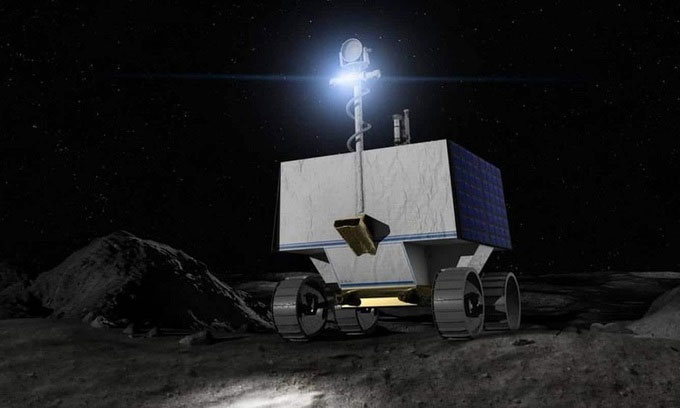NASA will put a $433.5 million robot on the Moon
NASA is planning to launch the first mobile robot to the Moon in 2023 to search for ice and other resources above and below ground.
Data from the Volatile Research and Polar Exploration Robot (VIPER) will help NASA map resources at the Moon's south pole, which can be collected in the future to serve humans in the long term. VIPER's design used floodlights for the first time to aid in the exploration of the dark side of the Moon. This region, which has been without light for billions of years, is among the coldest spots in the solar system. Operated by solar energy, VIPER needs to quickly conduct operations at the South pole of the Moon.

Simulate VIPER robot operating in the dark side of the Moon. (Photo: NASA).
"The data received from VIPER has the potential to help scientists determine the exact location and density of ice on the Moon, thereby assessing the environment and potential resources at the Moon's south pole to prepare for missions. astronauts in the Artemis program , " said Lori Glaze, director of NASA's Planetary Science Division at headquarters in Washington. "This is yet another example of how robotics and human exploration are closely related and both are essential as we prepare to sustainably inhabit the Moon."
NASA assigned Astrobotic the mission of launching and bringing VIPER to the surface of the Moon. Once on the Moon, the robot will explore craters, using specialized wheels and suspension systems to handle a variety of sloping surfaces and soil types. The design of the robot is significantly improved based on a previous design called Resource Prospector. VIPER's mission duration is 3 Moon days (equivalent to 100 Earth days). VIPER functions have also been upgraded to collect more data on the surface of the Moon.
VIPER will bring 4 instruments, including Ice Drill and Topsoil for New Terrain Exploration (TRIDENT), Mass Spectrometer for Observing Lunar Activity (MSolo), Near Infrared Spectrometer System ( NIRVSS) and the Neutron Spectrometer System (NSS). Initial versions of these instruments will be tested on the lunar surface prior to the VIPER mission, helping the team reduce risks and verify operational data. The cost for this medium-sized robot model is 433.5 million USD.
"VIPER will be the most powerful robot NASA has ever sent to the lunar surface, allowing humans to explore areas never seen before , " said Sarah Noble, VIPER program scientist. "This robot will tell us about the origin and distribution of water on the Moon to prepare to exploit resources more than 386,000 km from Earth, which can be used to send astronauts further into space. , including Mars".
Through the Artemis program, NASA will send robots and astronauts to explore the Moon. When the astronauts returned to the Moon for the first time since 1972, they would follow the wheel of VIPER and land at the south pole.
Operate and exploit advertising by iCOMM Vietnam Media and Technology Joint Stock Company.
116 Thai Ha, Trung Liet Ward, Dong Da District, Hanoi.
Email: info@more.edu.vn
Editor in chief: Tran Vo
Tel: (+84) 903076053/7 Fax: (+84) 903030935